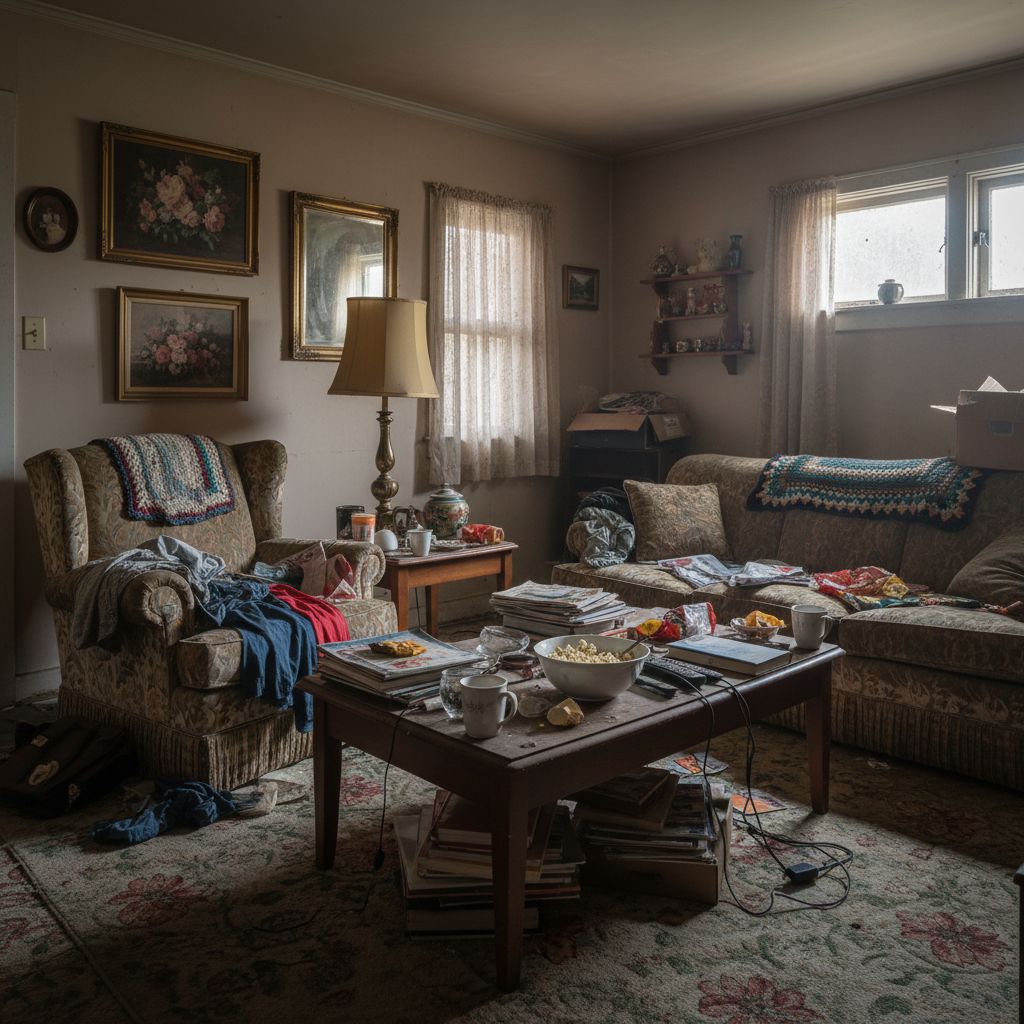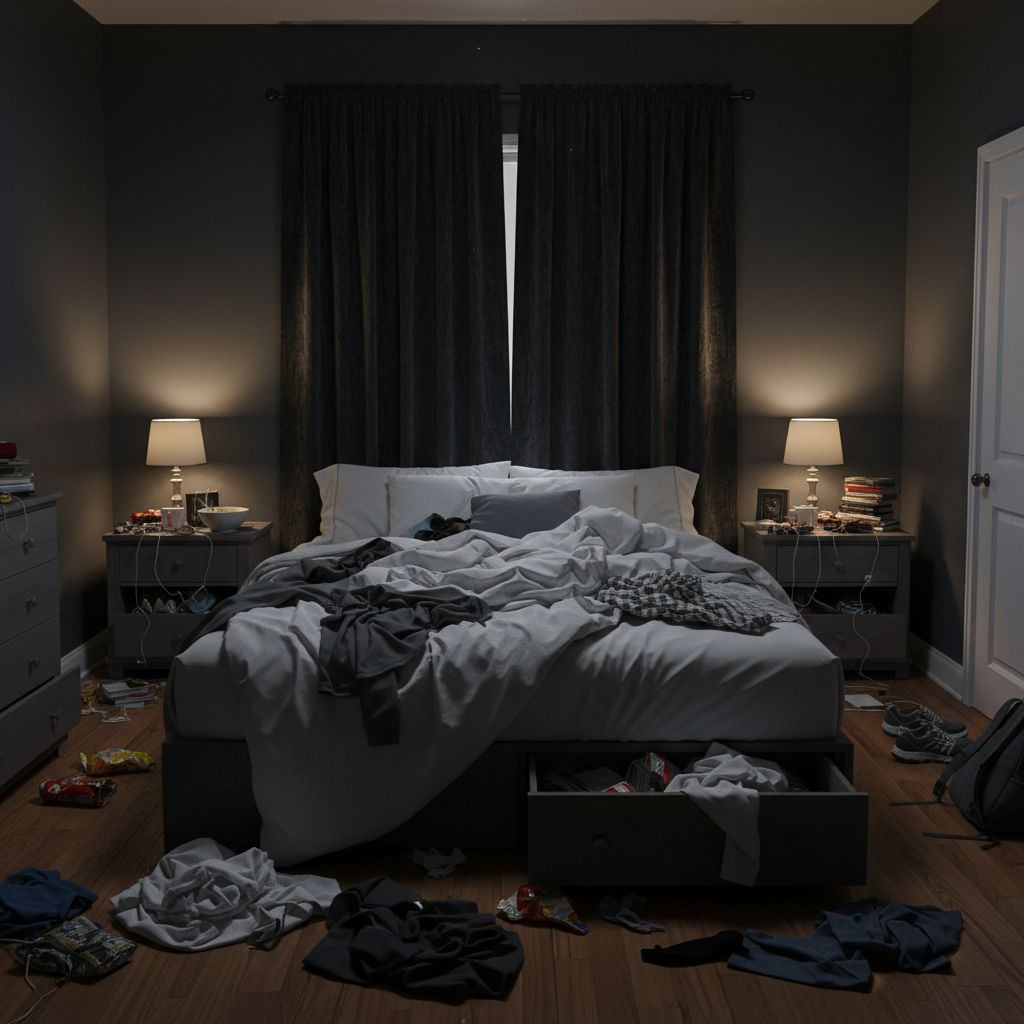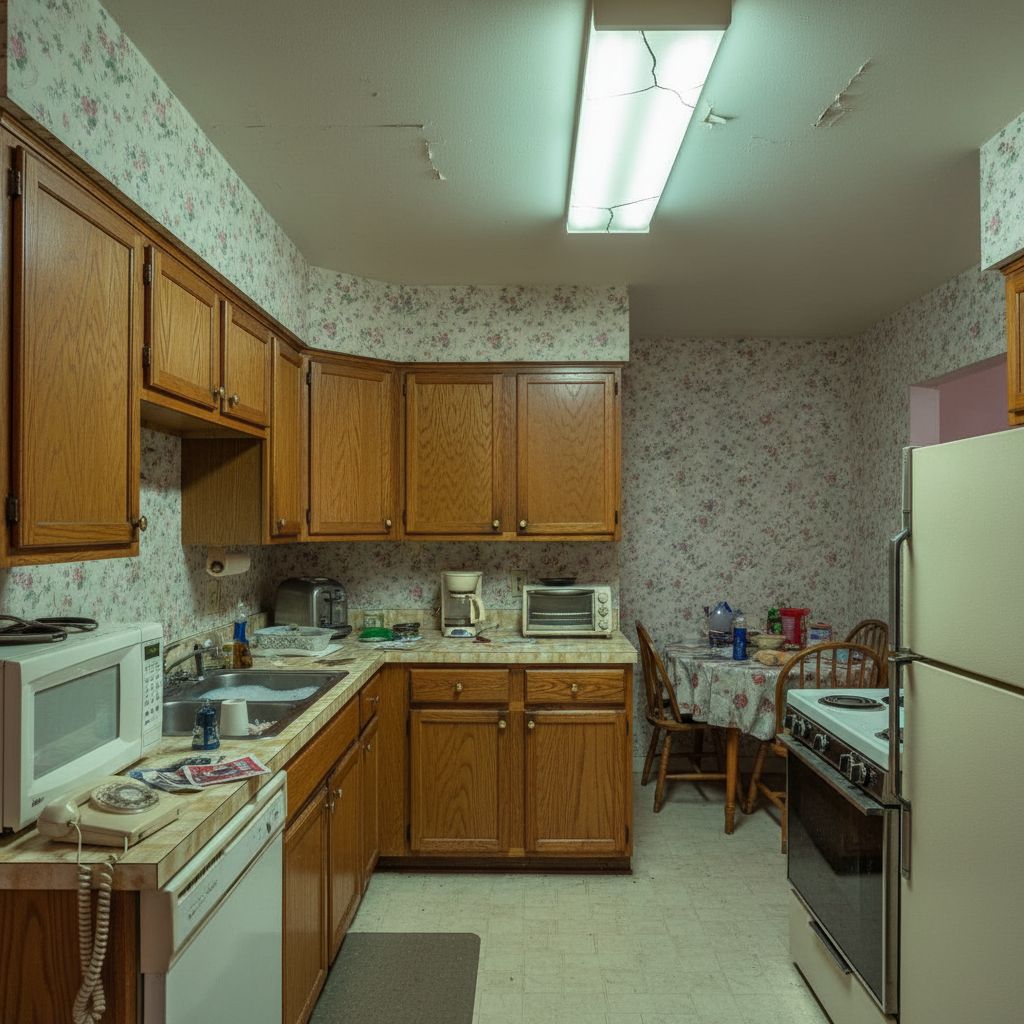
You don't need a complicated design scheme or thousands of dollars to create a beautiful home. Simple house interior design focuses on what truly matters: functionality, comfort, and peace of mind. If you've ever felt overwhelmed by design advice telling you to buy more, do more, and style more, this guide is for you.
Simple design isn't about deprivation—it's about intention. This comprehensive guide shows you how to create a home that feels calm, looks pulled-together, and actually works for your real life, all without breaking the bank or spending every weekend on home projects.
What Makes Interior Design "Simple"?
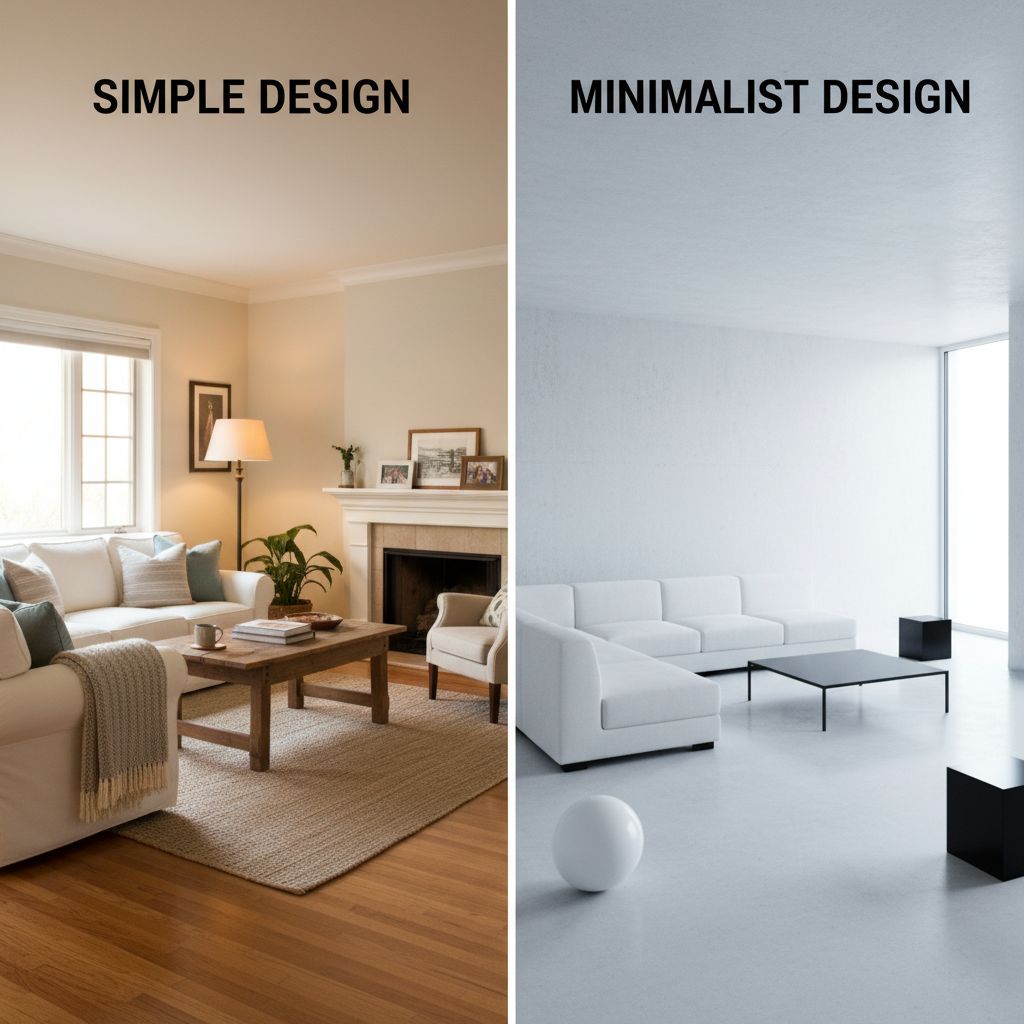
"Simple" doesn't mean bare, boring, or basic. It means intentional, uncluttered, and easy to maintain. Understanding what truly makes design simple helps you create spaces that serve your life rather than complicate it.
Simple vs Minimalist vs Basic Design
Simple Design
Focuses on essential elements that serve a purpose while maintaining visual appeal and personal warmth.
- Keeps what you love and use
- Warm, lived-in feeling
- Practical and comfortable
- Easy to clean and maintain
- Personal touches welcome
Minimalist Design
Extreme reduction to absolute essentials with strict aesthetic rules and often stark environments.
- Removes almost everything
- Can feel cold or unwelcoming
- Strict color limitations
- Design philosophy driven
- May sacrifice comfort for look
Basic Design
Functional but lacks intentional style, often resulting from budget constraints rather than choice.
- Generic furniture placement
- No cohesive color scheme
- Mismatched elements
- Purely functional focus
- Often accidental, not planned
The Psychology of Simple Design
Research consistently shows that cluttered, visually complex environments increase cortisol levels and mental fatigue. A Princeton University study found that physical clutter competes for your attention, reducing performance and increasing stress. Simple design directly addresses these issues.
Mental Health Benefits
- Reduced Stress: Fewer visual distractions mean lower anxiety and better focus
- Better Sleep: Simple bedrooms promote relaxation and improve sleep quality
- Increased Productivity: Clean spaces help you think clearly and work efficiently
- Improved Mood: Organized environments correlate with better emotional wellbeing
Practical Life Benefits
- Easier Cleaning: Less stuff means 50-70% reduction in cleaning time
- Lower Costs: Stop buying unnecessary decor and organization systems
- More Free Time: Less maintenance means more time for what matters
- Better Organization: Everything has a place and purpose
Cost Benefits of Simple Approaches
Simple design saves money both immediately and long-term. By focusing on quality over quantity and function over trends, you avoid the expensive cycle of constantly updating your decor.
Initial Savings
40-60%
Less on unnecessary items and trendy pieces
Maintenance Costs
$500-1,500/year
Saved on cleaning supplies and replacements
Time Value
10-15 hrs/month
Freed up from cleaning and organizing
The Simple Design Philosophy
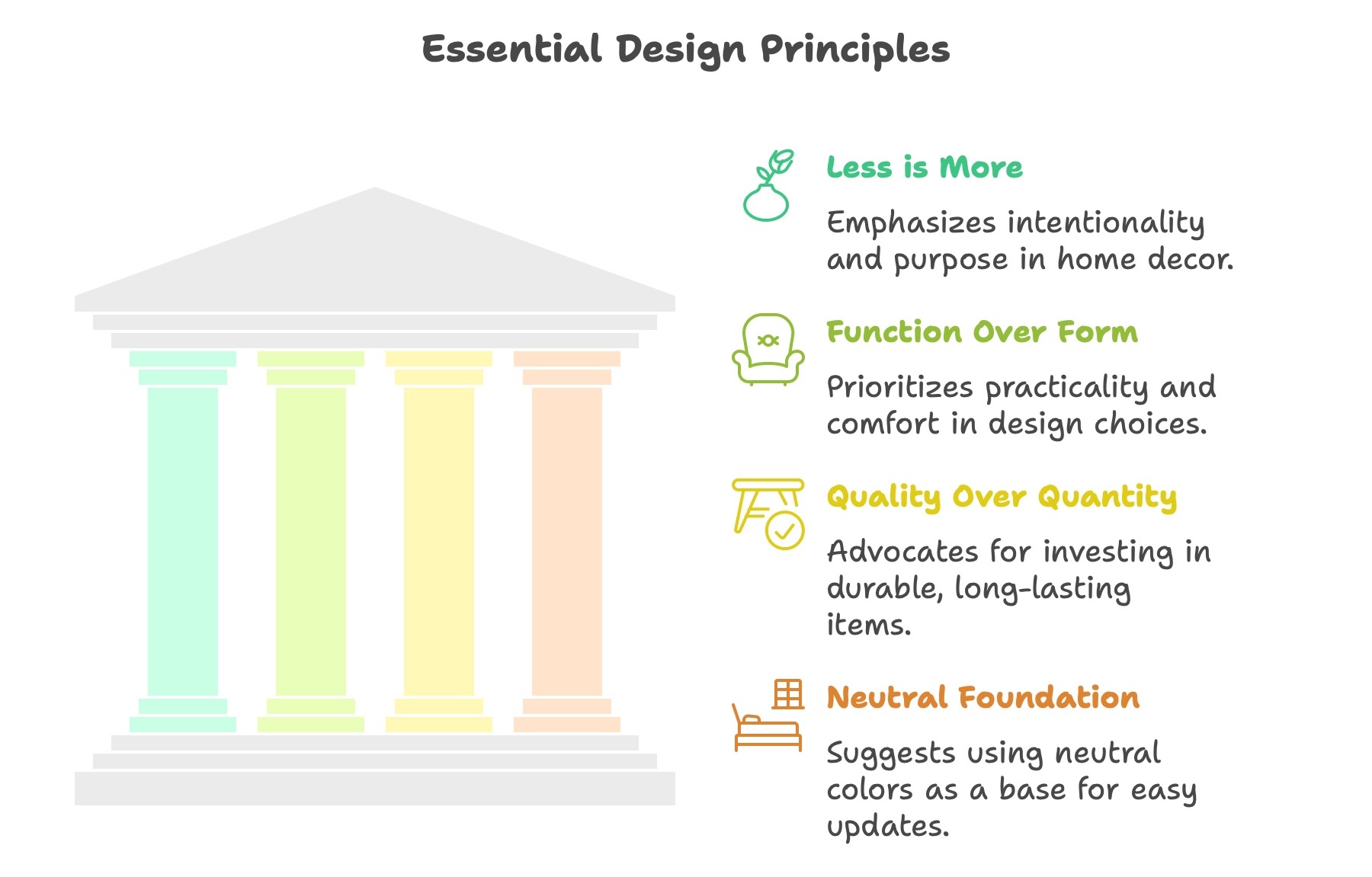
Simple design follows four core principles that guide every decision. These aren't rigid rules but flexible guidelines that help you create spaces that work for your actual life.
Core Principles
Less is More Application
This doesn't mean removing everything—it means being intentional. Every item in your home should either serve a purpose or bring you genuine joy. Not both; either is enough.
In Practice:
- One good sofa beats three mediocre chairs
- Empty counter space is valuable
- Five items you love > 20 you tolerate
Function Over Form
Beautiful design that doesn't work for your life isn't good design. Prioritize how you actually live—comfort, storage, and daily ease—then make those functional choices look good.
Real Examples:
- Washable slipcovers for families with kids
- Closed storage for visual calm
- Comfortable seating over trendy pieces
Quality Over Quantity
One well-made piece that lasts 10 years costs less and looks better than replacing cheap furniture every 2 years. Simple design means buying less but buying better.
Investment Priorities:
- Sofa: $800-2,000 (use daily for 7-10 years)
- Mattress: $600-1,500 (8 hours daily for 8-10 years)
- Dining table: $400-1,200 (family hub for 10+ years)
Neutral Foundation Approach
Start with neutral walls, floors, and major furniture. This creates a calm backdrop that's easy to update with accessories, costs less to change, and works with any style evolution.
The 80/20 Rule:
- 80% neutral: walls, floors, big furniture
- 20% color: pillows, art, accessories
- Easy to refresh without major cost
The Simple Design Test
Before buying anything or making any design decision, ask yourself these three questions:
1. Does it serve a purpose?
If it's purely decorative, make sure you truly love it—not just like it.
2. Do I have space for it?
Both physical space and mental space. Clutter creates stress even if "organized."
3. Can I maintain it easily?
If it requires special care you won't do, it'll become a source of guilt.
Room-by-Room Simple Design Ideas

Each room has different needs and challenges. Here's how to apply simple design principles to create functional, beautiful spaces throughout your home.
Living Room Simplicity

Furniture Selection Guidelines
Your living room needs seating, a surface for drinks, and good lighting. Everything else is optional. Start with these essentials and only add if you have a specific need.
- One quality sofa in neutral fabric (seats 3-4 comfortably)
- Coffee table with hidden storage (keeps surfaces clear)
- One accent chair if space allows (adds flexibility without clutter)
- Simple lighting with floor lamp and table lamp (no complicated fixtures)
The 3-Color Rule
Limit your living room to three main colors: one neutral dominant color (60%), one secondary color (30%), and one accent (10%). This creates cohesion without complexity.
Example 1: Warm & Cozy
Example 2: Cool & Clean
Quick Tip
Use your accent color in 3-5 places around the room (pillows, one piece of art, a throw blanket) for balanced visual interest.
Storage Solutions That Hide Clutter
Ottoman with Storage
Stores blankets, remotes, toys while providing extra seating. Budget: $80-200
Console with Drawers
Behind sofa or under TV for hidden organization. Budget: $150-400
Closed Shelving
Cabinets with doors keep visual clutter contained. Budget: $200-600
Simple Bedroom Design

Essential Elements Only
Bedrooms should promote rest and relaxation. Remove anything that doesn't directly support sleep, dressing, or unwinding.
- Quality bed and mattress (invest here—it's 1/3 of your life)
- Two bedside tables (symmetry creates calm, storage reduces clutter)
- One dresser or closet system (not both—choose based on space)
- Simple window treatment (blackout if needed for sleep quality)
What to Remove
These items often accumulate in bedrooms but undermine the peaceful atmosphere needed for good sleep:
- ✗ Exercise equipment (creates guilt when you see it; move to another space)
- ✗ Work materials (maintains work-life separation for better sleep)
- ✗ TV or screens (if possible—blue light disrupts sleep cycles)
- ✗ Excess decorative pillows (more than 2-4 becomes daily chore)
Color Psychology
Studies show cool colors (blues, greens, soft grays) promote better sleep. Limit warm reds and oranges to small accents. White and beige create neutral calm.
Simple Kitchen Organization

Counter Space is Premium
Keep only daily-use items on counters. Everything else goes in cabinets. Clear counters make cooking easier, cleaning faster, and the space feel larger.
Keep Out (Maximum 3-5 items):
- Coffee maker (if used daily)
- Knife block or utensil holder
- Frequently used cutting board
- Dish soap and sponge (contained)
Store Away:
- Small appliances (toaster, blender, etc.)
- Decorative items and cookbooks
- Seasonal tools and gadgets
- Excess dish towels and cleaning supplies
The One-In-One-Out Rule
Kitchens accumulate tools and gadgets. Before buying anything new, donate or discard something similar. This prevents drawer overflow and decision fatigue.
Storage Zones
Organize by use, not category:
- Cooking zone near stove (pots, pans, utensils)
- Prep zone near sink (cutting boards, knives, bowls)
- Storage zone in pantry (food, containers, bulk items)
- Serving zone near table (plates, glasses, napkins)
Cabinet Organization Hack
Use uniform containers for dry goods. Clear bins show contents at a glance, stack efficiently, and make everything feel intentionally organized even if it's just Rice Krispies and pasta.
Simple Bathroom Updates

Minimal Product Display
Bathrooms feel cluttered fast. Keep surfaces clear and products hidden for a spa-like feel that's actually easier to maintain.
- Under-sink storage for backup products and cleaning supplies
- Medicine cabinet for daily-use items (keeps counter clear)
- Shower caddy with only currently-used products
- Matching towels in 1-2 colors (creates instant cohesion)
Quick Visual Impact
These small changes make bathrooms feel immediately more put-together:
Replace Hardware
New drawer pulls and towel bars in matching finish (brushed nickel or matte black). Cost: $30-80, Time: 1 hour
Upgrade Textiles
Quality white towels and a simple bath mat. Crisp white always looks clean and luxurious. Cost: $50-150
Add One Plant
Pothos or snake plant thrives in humidity. Adds life without clutter. Cost: $10-30
Better Lighting
If you have Hollywood-style bulbs, switch to warm white LEDs. More flattering and energy efficient. Cost: $15-40
Try AI Design for Your Rooms
Want to see how simple design would look in your actual space? Decoratly's AI can transform your room photos into simple, clean designs in seconds. Try different color schemes and layouts before buying anything.
2 free room designs • See simple styles instantly
Simple Design on Different Budgets

Simple design works at any budget level. The key is focusing your spending on pieces that make the biggest impact and skipping the unnecessary extras that complicate your space and drain your wallet.
Under $500 Transformations
Budget Breakdown
- Decluttering supplies: $30-50 (bins, labels)
- Paint: $80-120 (one room, neutral color)
- Textiles: $100-150 (curtains, throw pillows, rug)
- Lighting: $80-120 (new lamp or fixture)
- Storage solutions: $60-100 (baskets, organizers)
- Remaining: $50-100 (fills, touch-ups)
Maximum Impact Moves
- Paint one accent wall in your chosen neutral (instant refresh)
- Declutter ruthlessly (free and transforms the space immediately)
- Replace all throw pillows in cohesive colors
- Add one quality area rug (anchors the space)
DIY Projects for This Budget
Furniture Refresh
Sand and paint existing furniture in crisp white or warm gray. Cost: $40-80, Time: Weekend project
Simple Art Wall
Frame family photos or free prints in matching frames from dollar store. Cost: $25-50, Time: 2 hours
Custom Storage
Use tension rods, hooks, and baskets to create organized closet system. Cost: $30-60, Time: 3 hours
Shopping Strategy
Hit IKEA for storage, Target for textiles, and use paint samples to test colors before committing. Buy one room at a time and finish completely before moving to the next.
Real Example: Sarah's Living Room
"I spent $480 total: $95 on soft gray paint, $120 on a cream area rug from Target, $85 on three matching throw pillows, $90 on a modern floor lamp from IKEA, and $90 on floating shelves and baskets. The biggest change came from removing half my furniture and organizing what remained. My stress level dropped immediately."
Timeline: 2 weekends (1 for decluttering/painting, 1 for setup) • Total savings vs designer: ~$2,000
$500-$2,000 Budget Plans
Budget Allocation
- One major furniture piece: $300-800
- Paint (multiple rooms): $150-250
- Lighting upgrades: $200-400
- Window treatments: $150-300
- Storage solutions: $100-250
- Textiles and accessories: $200-400
- Professional help (optional): $200-300
Investment Priorities
- Quality sofa or bed frame (you use daily, makes huge visual impact)
- Professional painting (perfect finish worth the cost if budget allows)
- Custom closet system (one-time investment that maintains simplicity)
Where to Save
- Decorative accessories (thrift stores and sales have great options)
- Side tables (IKEA hacks work perfectly for simple style)
- Art and frames (affordable prints look great in simple frames)
Smart Shopping Approach
Mix sources strategically:
- West Elm or Article for main furniture piece
- IKEA for storage and organization
- Target for textiles and accessories
- Facebook Marketplace for vintage finds
Real Example: The Martinez Family
"We spent $1,847 on our whole main floor. A new Article sofa ($895), professional painting ($450), new linen curtains from West Elm ($180), an IKEA storage system ($245), and simple accessories ($77). We sold our old furniture for $400, bringing our actual cost to $1,447. The house feels twice as big now."
Timeline: 6 weeks total (waiting for sofa delivery) • Result: Completely transformed living room and dining room
$2,000+ Complete Redesigns
Comprehensive Budget
- Major furniture (2-3 pieces): $1,200-2,500
- Professional services: $400-800
- Lighting design: $300-600
- Window treatments (custom): $400-800
- Flooring refresh: $500-1,500
- Built-in storage: $600-1,200
- Quality accessories: $300-600
Investment Strategy
- Timeless quality pieces that will last 10+ years
- Custom solutions for perfect fit and maximum simplicity
- Professional consultation to avoid expensive mistakes
Premium Simple Sources
Room & Board
American-made furniture with clean lines. Worth the investment for quality and longevity.
Custom Closet Companies
California Closets or similar for built-in organization that maintains simplicity forever.
Local Artisans
Custom wood furniture in simple designs supports local and gets exactly what you need.
Designer vs DIY
At this budget, consider hiring a designer for 2-3 consultation hours ($300-500). They'll help you avoid mistakes and source better pieces than you'd find alone.
Real Example: Complete Home Transformation
"We invested $5,200 over 8 months: custom built-ins ($1,800), two quality sofas ($2,200), professional painting and flooring ($900), and window treatments plus accessories ($300). We focused on creating a calm, organized home where everything has its place. Five years later, we haven't needed to buy anything new—it still works perfectly."
Cost per year: $1,040 • Compared to constantly updating: Saved $3,000+ annually on new decor and organization products
Universal Budget Tips
Buy Once, Buy Right
One $800 quality sofa that lasts 10 years costs less than three $300 sofas over the same period
Wait for Sales
Major retailers have predictable sales: President's Day, Memorial Day, Labor Day, Black Friday
One Room at a Time
Complete one space fully before starting another. Partial rooms drain budgets without satisfaction
50 Simple Design Ideas with Photos
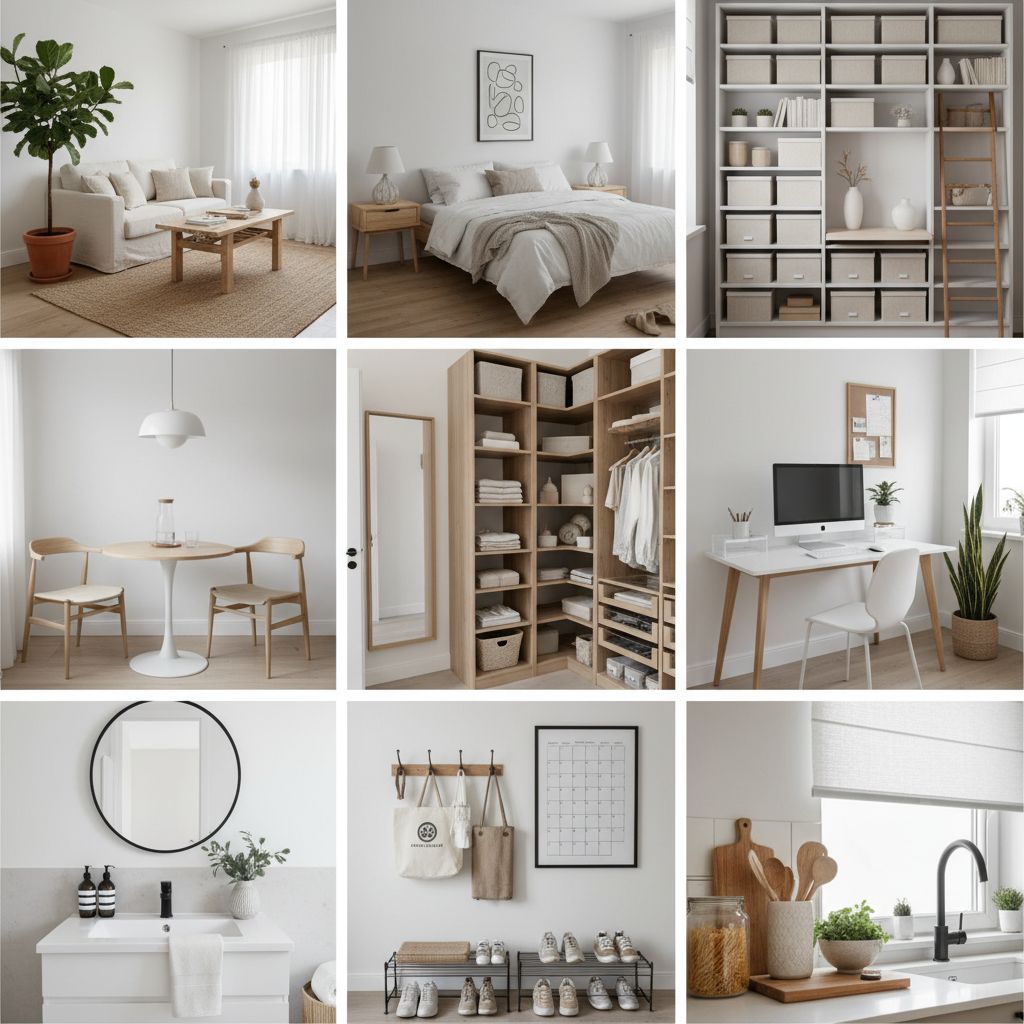
These practical ideas are organized by room and budget level. Each includes cost estimates and implementation difficulty so you can choose what works for your situation.
Living Room Ideas (1-15)
1. Neutral Sofa Foundation
Choose gray, beige, or cream. Works with any style evolution.
Cost: $600-2,000 • Difficulty: Easy
2. Floating Shelves
Display 3-5 items max per shelf. Keep rest of wall empty.
Cost: $40-120 • Difficulty: Medium
3. Single Large Plant
Fiddle leaf fig or monstera in corner. One statement plant > many small ones.
Cost: $30-80 • Difficulty: Easy
4. Ottoman Coffee Table
Soft edges, hidden storage, extra seating when needed.
Cost: $150-400 • Difficulty: Easy
5. Hide TV Cords
Cable management kit or in-wall routing for clean look.
Cost: $20-200 • Difficulty: Medium
6. Matching Throw Pillows
2-4 pillows in coordinating colors. Replace annually for refresh.
Cost: $40-120 • Difficulty: Easy
7. Single Area Rug
Large enough for all furniture legs. Anchors seating area.
Cost: $150-800 • Difficulty: Easy
8. Floor Lamp Only
Eliminate multiple light sources. One quality arc or tripod lamp.
Cost: $80-250 • Difficulty: Easy
9. Gallery Wall (3 frames)
Same frame style, simple mats. Family photos or art prints.
Cost: $50-150 • Difficulty: Medium
10. Closed Storage Console
Behind sofa or under TV. Hides all the stuff.
Cost: $200-600 • Difficulty: Easy
11. Remove Side Tables
One coffee table often enough. Reduces visual clutter.
Cost: $0 • Difficulty: Easy
12. White or Light Walls
Reflects light, makes space feel larger. Timeless backdrop.
Cost: $100-200/room • Difficulty: Medium
13. Basket for Remotes
One beautiful basket on coffee table contains all controls.
Cost: $15-40 • Difficulty: Easy
14. Floating TV Unit
Wall-mounted for clean floor space underneath.
Cost: $150-500 • Difficulty: Hard
15. Single Accent Color
Choose one: navy, sage green, terracotta. Use in 3-5 small items.
Cost: $50-200 • Difficulty: Easy
Bedroom Ideas (16-30)
16. All-White Bedding
Hotel-style luxury. Easy to wash, always looks fresh.
Cost: $80-250 • Difficulty: Easy
17. Matching Nightstands
Symmetry creates calm. Same style, simple design.
Cost: $150-400 • Difficulty: Easy
18. Under-Bed Storage
Boxes or drawers for seasonal items. Out of sight.
Cost: $40-150 • Difficulty: Easy
19. Minimal Decor Pillows
Maximum 2-3. You remove them daily anyway.
Cost: $30-90 • Difficulty: Easy
20. Wall-Mounted Reading Lights
Frees nightstand space. Clean modern look.
Cost: $60-200 • Difficulty: Hard
21. Blackout Curtains
Simple panels in neutral. Better sleep, cleaner look.
Cost: $60-200 • Difficulty: Easy
22. Platform Bed Frame
Low profile, no box spring needed. Modern and simple.
Cost: $300-1,000 • Difficulty: Medium
23. Remove TV
Bedroom for sleep only. Proven to improve rest quality.
Cost: $0 • Difficulty: Easy (mentally hard!)
24. One Piece of Art
Large above bed. Calm landscape or abstract.
Cost: $40-200 • Difficulty: Easy
25. Closet Organizer System
Everything has a place. Maintains bedroom calm.
Cost: $100-1,000 • Difficulty: Medium
26. Soft Neutral Walls
Warm gray, soft beige, or pale blue for restful sleep.
Cost: $80-150 • Difficulty: Medium
27. Quality Mattress
Biggest bedroom investment. Worth every penny for health.
Cost: $600-2,000 • Difficulty: Easy
28. Uniform Hangers
Slim velvet hangers save space, look organized.
Cost: $25-60 • Difficulty: Easy
29. Bench at Foot of Bed
For clothes, seating, or storage. Simple upholstered style.
Cost: $100-400 • Difficulty: Easy
30. Clear Nightstand Tops
Lamp, book, glass of water max. Use drawers for rest.
Cost: $0 • Difficulty: Easy
Kitchen & Dining Ideas (31-45)
31. Clear Countertops
Only 2-3 daily items visible. Everything else stored.
Cost: $0 • Difficulty: Medium (habit change)
32. Matching Containers
Uniform glass or plastic for pantry items. Instantly organized look.
Cost: $40-120 • Difficulty: Easy
33. Open Shelving (limited)
One wall only. Display 5-7 beautiful items.
Cost: $60-200 • Difficulty: Medium
34. Under-Sink Organization
Tiered shelves or pull-out drawers. Maximize cabinet space.
Cost: $25-80 • Difficulty: Easy
35. Simple Dining Table
Wood or white. No tablecloth needed. Easy to clean.
Cost: $300-1,200 • Difficulty: Easy
36. Matching Dishware
White or cream set. Timeless, mix-and-match friendly.
Cost: $80-250 • Difficulty: Easy
37. One Centerpiece Only
Simple bowl of fruit or single vase. Nothing else on table.
Cost: $20-60 • Difficulty: Easy
38. Drawer Organizers
Bamboo or acrylic dividers. Every utensil has a spot.
Cost: $30-90 • Difficulty: Easy
39. Appliance Garage
Cabinet or corner for small appliances. Clean counters daily.
Cost: $40-150 (DIY) • Difficulty: Medium
40. Neutral Backsplash
White subway tile or light stone. Works with everything.
Cost: $300-1,000 • Difficulty: Hard
41. Single Kitchen Rug
Washable runner in neutral. Comfort while cooking.
Cost: $40-120 • Difficulty: Easy
42. Identical Chairs
Set of 4-6 matching dining chairs. Cohesive look.
Cost: $200-800 • Difficulty: Easy
43. Pot Lid Organizer
Vertical storage in cabinet. No more digging.
Cost: $15-40 • Difficulty: Easy
44. Minimal Window Treatment
Simple blinds or no covering if private. Maximum light.
Cost: $30-150 • Difficulty: Easy
45. Lazy Susan in Cabinets
Corner cabinets become functional. Easy access to everything.
Cost: $20-60 • Difficulty: Easy
Bathroom & General Ideas (46-50)
46. All-White Towels
Spa-like feel. Can bleach when needed. Always matches.
Cost: $50-150 • Difficulty: Easy
47. Hidden Products
Medicine cabinet or under-sink only. Clear counters entirely.
Cost: $0 • Difficulty: Easy
48. Simple Bath Mat
White or neutral, washable. Replace when worn.
Cost: $20-50 • Difficulty: Easy
49. Consistent Hardware
All chrome, all matte black, or all brass throughout home.
Cost: $100-400 • Difficulty: Medium
50. Natural Light Maximum
Remove heavy curtains. Clean windows regularly. Less stuff near windows.
Cost: $0 • Difficulty: Easy
Start Small, Build Simple
You don't need to implement all 50 ideas at once. Pick 3-5 that resonate with your biggest pain points, start there, and build gradually. Simple design is a journey, not a destination.
Try simple designs with AI before buying anything
Implementation Timeline

How quickly you implement simple design depends on your budget, available time, and how drastic the changes. Here are realistic timelines for different approaches.
Weekend Projects (1-2 Days)
Saturday: Declutter & Organize
- 9am-12pm: Ruthlessly declutter one room. Donate bag ready by noon.
- 1pm-3pm: Organize remaining items. Everything gets a designated home.
- 3pm-5pm: Clean thoroughly. Vacuum, dust, wash surfaces.
Sunday: Refresh & Style
- 9am-12pm: Shop for 3-5 key items (pillows, plant, storage).
- 1pm-3pm: Arrange furniture for better flow. Install new items.
- 3pm-4pm: Step back, adjust, and photograph your success!
Expected Result: One completely transformed room that feels significantly calmer and more functional. Cost: $100-400
Month-Long Transformations (4 Weeks)
Week 1: Planning & Preparation
- Measure rooms and create basic floor plans
- Research and order major furniture piece(s)
- Begin decluttering process, one room per day
- Create shopping list and budget spreadsheet
Week 2: Deep Clean & Paint
- Move furniture to center, cover with sheets
- Paint walls in chosen neutral color
- Clean windows, baseboards, light fixtures
- Order window treatments and lighting
Week 3: Furniture & Layout
- Major furniture delivered and placed
- Install new lighting fixtures
- Hang curtains and window treatments
- Arrange furniture for optimal flow
Week 4: Finishing Touches
- Add textiles: rugs, pillows, throws
- Final declutter and organization
- Hang art and add minimal accessories
- Live with it a few days, make final adjustments
Expected Result: Complete transformation of 1-2 main rooms with new furniture, fresh paint, and cohesive simple design. Cost: $800-3,000
Seasonal Updates (3-4 Times Per Year)
Spring/Summer Refresh
Lighten and brighten for warmer months while maintaining your simple foundation.
- Switch to lighter-weight textiles (linen, cotton)
- Add fresh plants or flowers in simple vessels
- Roll up or remove heavy rugs for cooler floors
Fall/Winter Coziness
Add warmth and texture without cluttering your simple spaces.
- Layer in warmer throws and heavier pillows
- Add area rugs for warmth and sound absorption
- Incorporate warm lighting (amber bulbs, candles)
Time Investment: 2-3 hours per season • Cost: $50-200 for seasonal swaps
The Most Important Timeline: Right Now
The best time to start simplifying is today. Even 15 minutes of decluttering or removing one unnecessary item begins the transformation. Don't wait for the "perfect" plan or budget—start where you are with what you have.
Today (15 minutes)
Clear one surface completely. Counter, nightstand, or table.
This Week (1 hour)
Declutter one drawer or cabinet. Donate items you don't use.
This Month (1 day)
Complete one room following the weekend project timeline.
Common Simple Design Mistakes
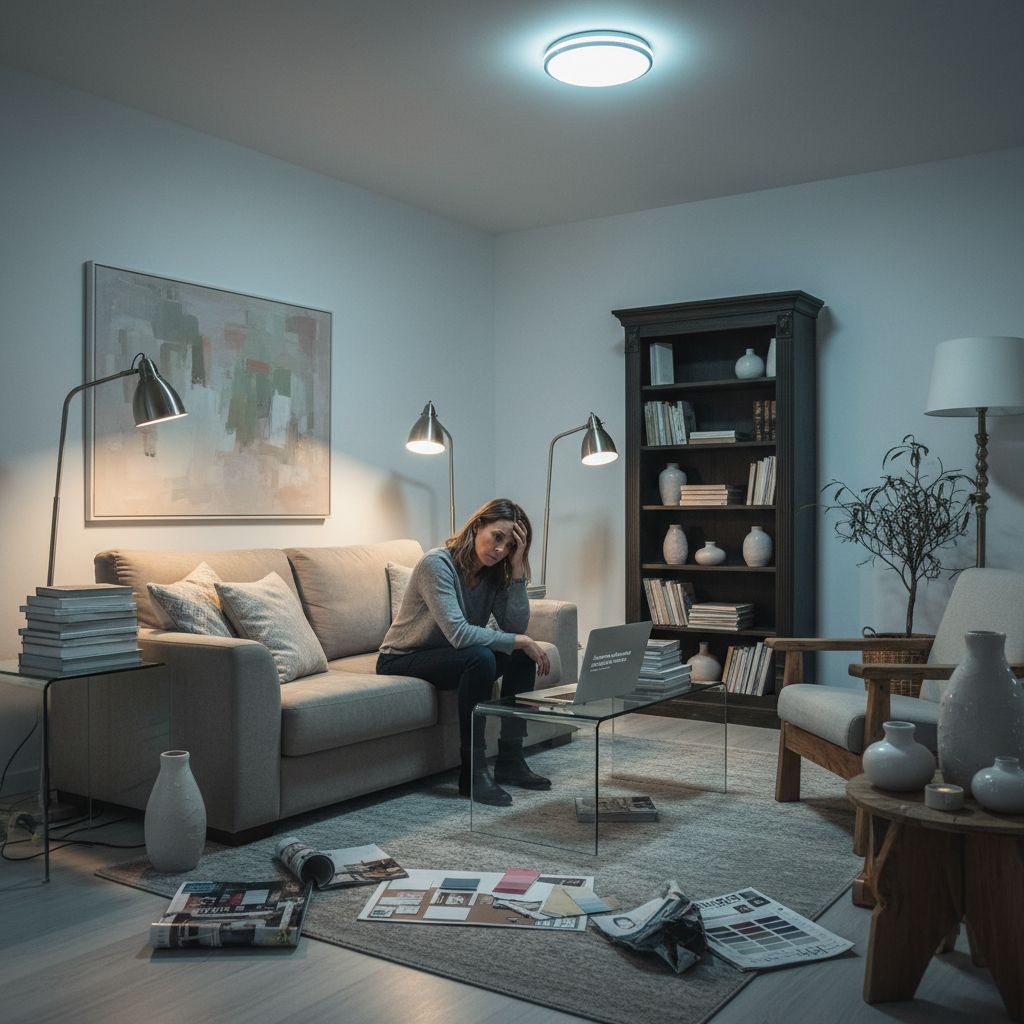
Even with good intentions, it's easy to derail simple design efforts. Recognizing these common pitfalls helps you stay on track and maintain the calm, functional spaces you're creating.
❌ Confusing Simple with Empty
Simple doesn't mean your home should feel barren or uninviting. You still need enough furniture to function comfortably and personal touches that make it feel like home.
Warning Signs
- Your guests have nowhere comfortable to sit
- You're constantly hunting for basic items
- The house feels cold and unwelcoming
- You removed things you actually needed
The Fix
- Keep essentials: enough seating, adequate lighting
- Add warmth through textiles and natural materials
- Display 3-5 meaningful personal items
- Ensure every room serves its intended purpose
❌ Buying "Organizers" Instead of Decluttering
The organizing industry thrives on selling solutions to problems that wouldn't exist if you just owned less. Containers and systems should come after decluttering, not instead of it.
The Right Order
- 1. Remove: Get rid of what you don't need or love
- 2. Organize: Group what remains by category and use
- 3. Containerize: Only then buy storage for what's left
If your "organizing" involves buying lots of bins and baskets, you're doing it backwards.
❌ Following Trends Over Personal Needs
Instagram-worthy doesn't always equal livable. Simple design should serve your actual life, not look good for photos.
Trend Traps
- All-white kitchen with small kids (impractical)
- Open shelving when you have limited dishware
- Removing your dining table for "flow"
- Getting rid of your TV when you actually watch it daily
Design for Your Life
- Choose durable, washable fabrics for family use
- Include storage that hides daily mess
- Keep furniture you actually use regularly
- Make decisions based on function first
❌ Keeping Things "Just in Case"
The most common excuse for clutter: "I might need this someday." Research shows we almost never use items we're saving "just in case."
The 20/20 Rule
If you can replace an item for under $20 in under 20 minutes, you don't need to keep it "just in case." The mental space it takes costs more than replacement would.
Exception: Specialized tools you actually use or items with sentimental value. Everything else should earn its space.
❌ Doing It All at Once
Trying to simplify your entire house in one weekend leads to burnout, hasty decisions, and often, regression. Sustainable change happens gradually.
The Better Approach
- Complete one room fully before moving to the next
- Live with changes for a week before adding more
- Celebrate small wins (cleared counter = success!)
- Give yourself 3-6 months for whole-house transformation
If You've Made These Mistakes
Don't worry—everyone does. The beauty of simple design is that it's easy to course-correct. Bought too many organizers? Return them or donate. Removed too much? Add back what you need. Simple design is flexible and forgiving.
Remember: Progress, not perfection. Each small improvement makes your home work better for you.
Simple Design Maintenance Guide
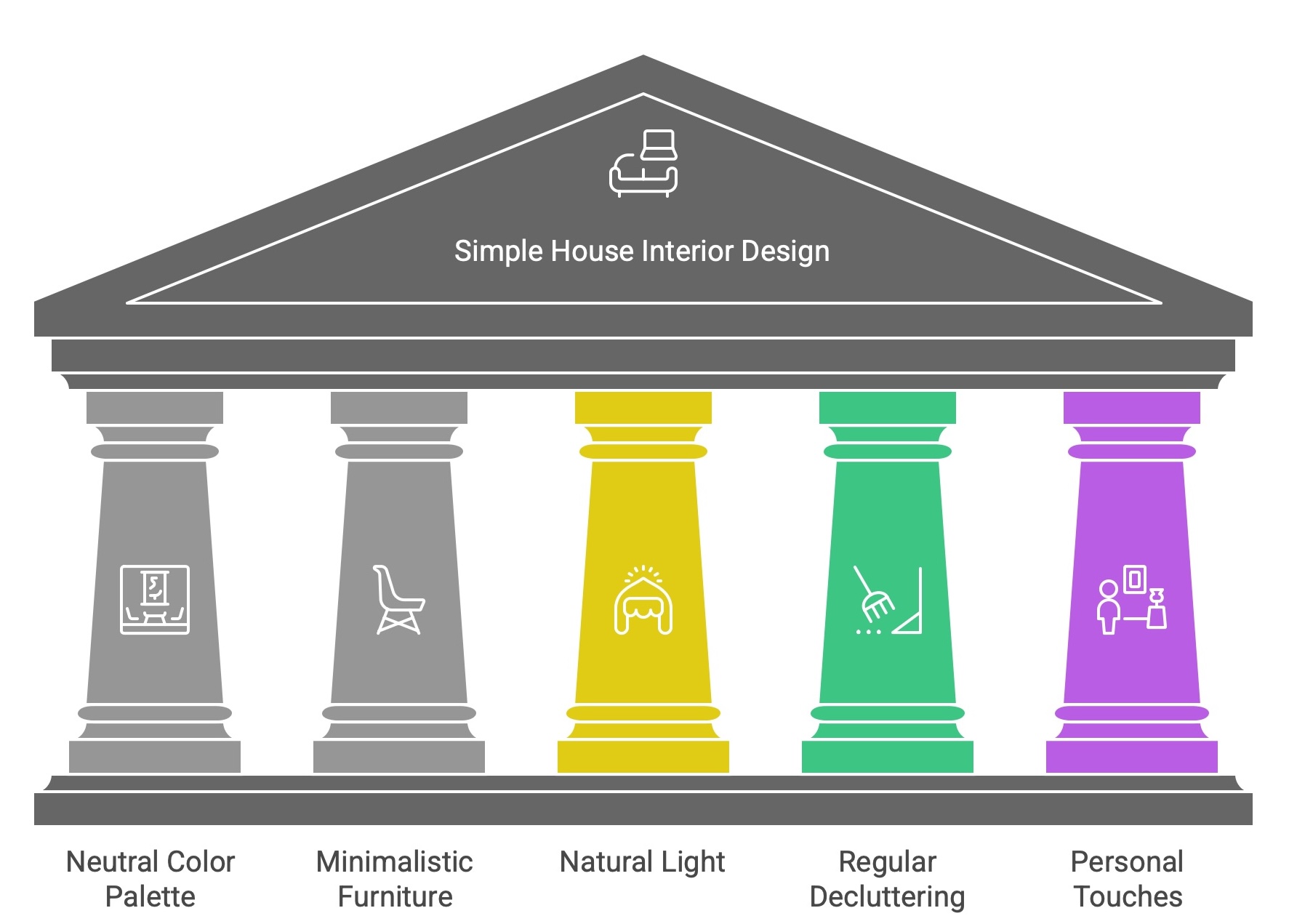
Creating a simple home is one thing; maintaining it is another. These habits and systems help you preserve the calm, organized spaces you've worked to create.
Daily Habits (5-10 Minutes)
Morning Reset
- Make bed immediately (sets tone for the day)
- Clear kitchen counters after breakfast
- Put away bathroom products after use
Evening Tidy
- 10-minute pickup before bed (everything to its place)
- Clear dining table and kitchen sink
- Reset living room (fluff pillows, fold throw)
The Rule: Never leave a room empty-handed. Taking one item back to its home as you move through the house prevents accumulation.
Weekly Maintenance (30-45 Minutes)
Surface Cleaning
With minimal items on surfaces, cleaning is incredibly fast. Dust shelves, wipe counters, vacuum floors. Simple spaces = simple cleaning.
Laundry & Linens
Wash and immediately put away. Simple design means you likely own fewer items, so laundry is easier to keep up with.
One-Touch Rule
Deal with mail, packages, and new items immediately. Open, decide (keep/donate/trash), and put away or discard right away.
Monthly Check-ins (1-2 Hours)
Declutter Review
Walk through each room with donation box. Remove items that haven't been used or that no longer fit your simple aesthetic.
Ask yourself: Have I used this in the past month? Does it serve a current purpose? Does it align with my simple design goals?
Organizational Tune-up
Check that your systems are working. Are items ending up in the right places? Do you need to adjust storage?
Refine systems: If you're constantly searching for something, it needs a better designated home. Adjust as needed.
Preventing New Clutter
The One-In-One-Out Rule
For every new item that enters your home, one similar item must leave. New shirt? Donate an old one. New kitchen gadget? Out goes the one it replaces.
24-Hour Rule for Purchases
Wait 24 hours before buying anything non-essential. This eliminates impulse purchases and gives you time to consider if you truly need it and where it will live.
Gift Management
Communicate your simple design preferences. It's okay to return or donate gifts that don't fit your space. Share a wish list of consumables (candles, favorite snacks) instead of items.
When Simplicity Slips
Life happens. Busy periods, holidays, illness, or major life changes can disrupt even the best systems. When you notice clutter creeping back:
Don't Panic
Temporary mess is normal. You haven't failed—you're just human.
Start Small
One surface, one drawer. Quick wins rebuild momentum.
Reset Rituals
Return to daily habits. Consistency matters more than perfection.
Ready to Simplify Your Space?
See how simple design would transform your actual rooms. Decoratly's AI lets you visualize different simple styles instantly—before you buy a single thing or move any furniture.
Try Before You Buy
See simple designs in your space
Compare Options
Test different color schemes instantly
Free to Start
2 room transformations included
No credit card required • See results in 30 seconds




